Now & New
- Experience
Kintaikyo Art Festival 2022: Celebrating Iwakuni’s Traditional Nocturnal Beauty
While Iwakuni is a popular day trip idea for those based in Hiroshima City, in all my years of living here, I must confess that I can count all the times I have been to Iwakuni on one hand. It’s a pretty humble city with not much to do outside the Kintaikyo area, thus tourists mainly visit during the day and leave by dusk. Historically, when night fell on the banks of the Nishiki River, local fishermen would set out on boats equipped with kagaribi (篝火 – かがりび), which were bonfires in iron baskets affixed to the bow to act as a precursor to night vision goggles, so to speak. They also trained cormorants, and would send these birds out to catch the fish that were swimming beneath the surface while relying on the faint light of the kagaribi to keep track of all the action. Today, this tradition continues in the form of special tours and experiences offered to visitors at night, but for one weekend out of the whole year, the glory of kagaribi is put on display to the general public as a fall festival.
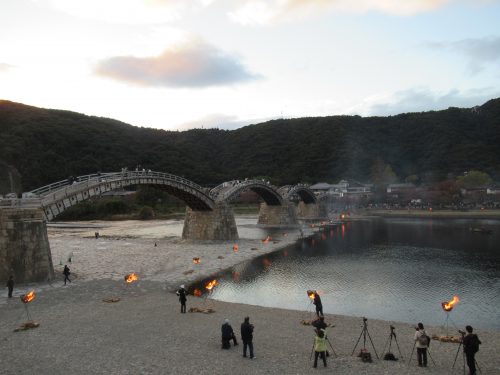
The Kintaikyo Art Festival showcases art produced by residents of the Iwakuni area, with pieces on display in the proximity of Kintaikyo near Kikko Park. These abstract, glowing ensembles capitalize on the gorgeous night view of Kintaikyo, which is accented by the radiant kagaribi that run across the Nishiki River itself. Since the festival lasts two days and different events take place each day, an overnight stay in Iwakuni would make sense, but sadly, this time I would only be able to join in on the festivities of the first day, which was Saturday, the 5th of November.
Super Early Start
When going to Kintaikyo from Hiroshima Station, one can board the JR Sanyo Red Line bound for Iwakuni Station, then take a bus to the bridge. However, Iwakuni Station has several bus platforms outside the west exit, so it’s imperative to know where to wait to board a Kintaikyo-bound bus. There are three platforms near the station and one more on the other side of the parking lot; unfortunately for me, that’s the one where I needed to wait that day and I didn’t even know of its existence. I was on the wrong side of the parking lot, so when I saw my bus departing and leaving the station area, I had to run to the side of the street and flag down that bus so the driver would let me on, but at least I made it.
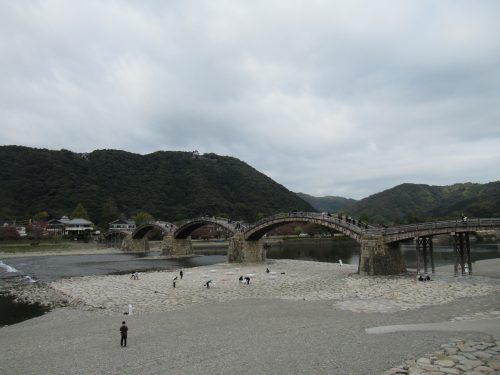
It was half past ten by the time I reached Kintaikyo, and despite the initially cloudy skies, the weather would get prettier as the day went on. As can be seen from the picture above, the crew were still setting up the luminescent art displays and the festivities were nowhere near ready to begin. I figured that if I was to take a trip to Iwakuni to see the bridge at night, I might as well check out the museums during the day to make the most of my time. Early as it was, though, my tummy was already rumbling at this time, so I crossed the Kintaikyo and decided to have an early-bird lunch at Musashi, a local eatery that serves up over a hundred flavors of soft serve ice cream as well as some Iwakuni specialty entrées.
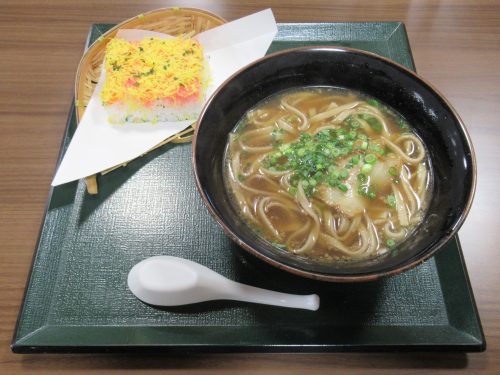
When it comes to Iwakuni local fare, the two that come to mind first and foremost are Iwakunizushi, a pressed sushi that is mass-produce and cut into squares for customers like lasagne, and renkonmen, which are noodles of any shape made from lotus root flour. Iwakunizushi may come with additional seafood toppings, but mine today just had the standard egg ribbons. My meal came with a coupon that gave me a ¥50 discount on an ice cream cone, but I opted to save that for the later afternoon when I would get hungrier.
Museum Stamp Rally
In honor of the Kintaikyo Art Festival, five of the museums in Kikko Park were participating in a stamp rally for the month, with prizes available for those who visit and obtain the stamp from all five locations. The duration of the stamp rally lasts beyond the actual dates of the festival because, let’s face it, who else besides yours truly would hit up all five museums and partake in the nighttime festivities in one weekend? Fortunately for me, all the museums were in proximity to each other so they can be efficiently visited in succession, and a stamp card can be obtained from any of the sites so I could start anywhere. My first destination on the route was the Sakai Sake Brewery Museum of Art “Gokyo Bunko,” a quaint little house that specializes in things that are carved, such as wooden teaspoons, personal seals, and printmaking works. Photography of the items on display was forbidden, but as they were giving away wooden tea scoops typically used in tea ceremonies as souvenirs, I took a picture of these meticulously carved utensils before taking one for myself.
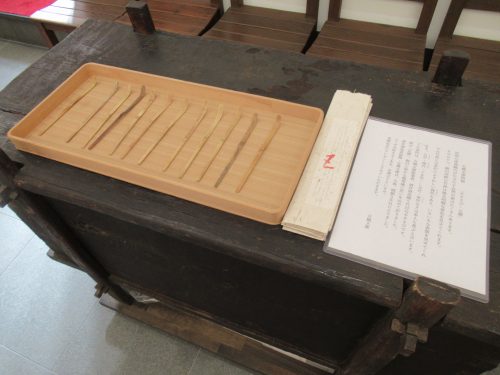
Back outside, I circled around en route to the second museum on my list, the Kikkawa Historical Museum. The exhibition here mostly consists of old weaponry and armor, and like the previous museum, this facility also forbids photography indoors. In the garden out back, they were putting on a limited-time miniature tea ceremony event where visitors could enjoy a cup of matcha and wagashi (Japanese-style sweets) while gazing out at the mountaintop Iwakuni Castle.
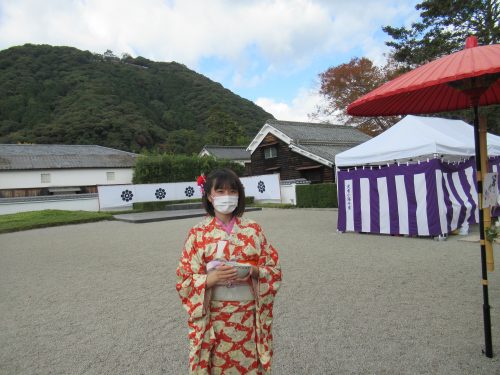
Lovely ladies in kimono brought me tea while I sat waiting in my chair, and they even offered me a free refill. I’ve participated in other tea ceremonies before wherein the tea master prepared the matcha right before my eyes and we sat seiza-style (seated on top of one’s lower legs, knees pointed forward), but the ceremony here wasn’t anything fancy like that. Since it was autumn, the wagashi took the form of autumnal vegetation such as a mushroom, some pine needles, and a gingko leaf. I took my sweet time (no pun intended) downing my tea and treats, then made tracks for the third museum.
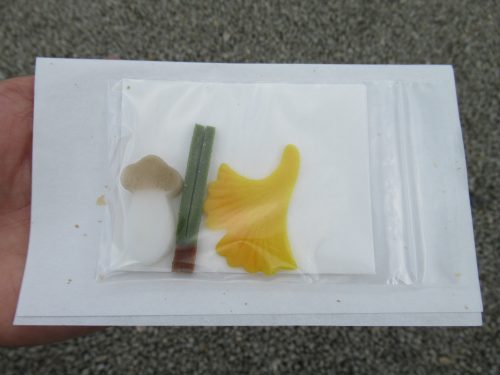
Up next was the Iwakuni Antiquities Museum, which focuses on the history of the Iwakuni Domain, especially as it relates to the construction of Kintaikyo. The items here are quite varied, with suits of armor, miniature models of Kintaikyo, and old documents, accompanied with educational movies explaining how the Iwakuni we know today came into being. Unlike the other museums, admission here is free, and since the exhibition can be seen in a flash, visitors can come mainly for the stamp and skedaddle.

Moment of Joy: Never Too Old to Play
There are those who may believe that stamp rallies and playing in the park are activities for juveniles, but I respectfully and strongly disagree. In the middle of Kikko Park was a verdant space filled with what looked like playground equipment, but was actually exercise equipment geared toward an elderly audience. Now I myself am not exactly a geezer, but I never turn down a chance to take a breather and test out playground equipment. Every piece of equipment came with instructions on how to use it as well as what muscles get worked out; getting in a brief moment of exercise was the perfect deterrent to museum burnout.
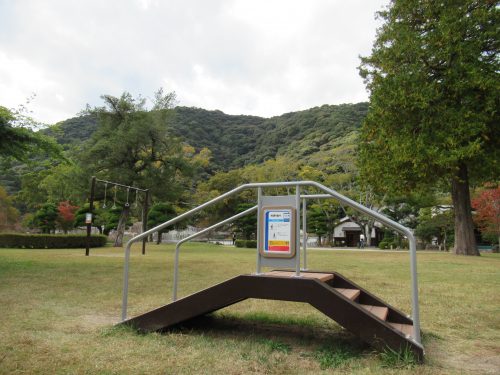
Leisurely Winding Down
With my muscles warmed up and pulsing again, I made my way to the fourth participating museum, the Iwakuni White Snake Museum. In the first room is a short film illustrating the history and reputation of albino snakes in the area, as well as a photo spot featuring a model white snake and samurai. Past that is a hall filled with kid-friendly exhibits informing visitors on the biology of white snakes and even some real, live white snakes behind glass. The snakes themselves are probably the only photogenic thing inside the museum, but due to how bad photos turn out thanks to the glass, filming them (if you’re lucky, they’ll be moving) is the best way to go.
It was around this time in the late afternoon that I was starting to feel peckish, so I momentarily put the museum stamp rally on hold and headed back to Musashi to use my soft serve ice cream coupon. This shop has over a hundred different flavors to choose from, from the classic favorites to the straight-up wacky, and many of them are swirl mixes so customers are essentially eating two flavors at once. I went for a Kyoho grape and blue lychee (which looks green here) swirl, sat myself on a bench in the park, and dug in!
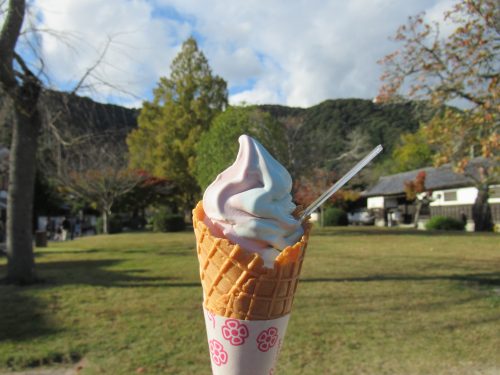
However, that wasn’t substantial enough for an afternoon snack, so I went to Kojiro, a nearby rival ice cream store that sells other typical Iwakuni fare. As I said before, lotus root is a rather renowned product of Iwakuni, so they’ll make any food with the vegetable if they can. I got myself a lotus root croquette, which also contained mashed potato and minced meat, a crispy, well-seasoned concoction that hit the spot.
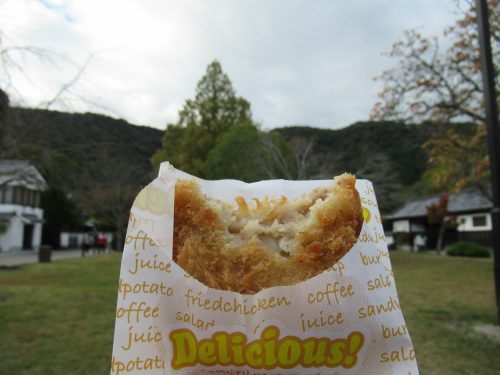
After finishing my afternoon snacks, I hit up the final museum in the stamp rally, the Kashiwara Museum of Art, which is located right by the ropeway station that takes tourists up to Iwakuni Castle. This is possibly the largest museum in the area, but even its three floors can be finished in a matter of minutes. The bulk of the collection inside is samurai armor and weapons, but there are also other objects and artworks used by the people of the time, such as folding screen paintings. Much to my dismay, photography of the works in here was also verboten, but one of the descriptive plaques by one of the folding screens had a message that stuck with me. It said that running a business is like setting up a folding screen picture: it looks more appealing the more it expands, but when stretched all the way, the screen falls to the ground. This is exactly how I feel about tourist sites when it comes to their capacity and popularity, and I am glad that Iwakuni has gradually been showing up on more tourists’ radars without turning into the hectic, overcrowded madhouses that other cities in Japan and around the world have inadvertently become.
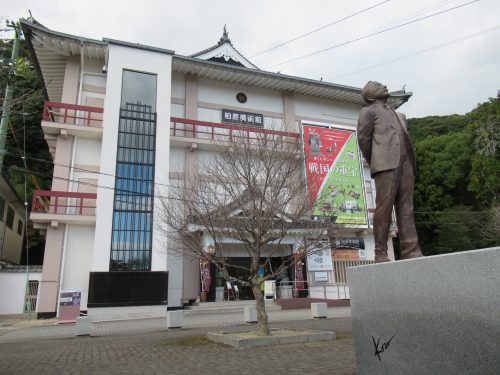
The Festivities Begin
It was fast approaching dusk when I finished seeing the last museum and completed my stamp card, so I went back to the “Gokyo Bunko” museum to redeem my presents, a reusable bag and metal water bottle with designs of some of the artworks I saw in the museums today. On my way there, I happened upon some of the locals lined up all along Kintaikyo singing some traditional songs out of local pride. They disappeared by the time I had redeemed my gifts, but as I knew that the kagaribi were about to be lit, I hurried over the Kinjo Bridge (the bridge running parallel to Kintaikyo that costs nothing to cross) to catch the Nishiki River reflecting the blue jewel of a sky shortly before sunset.
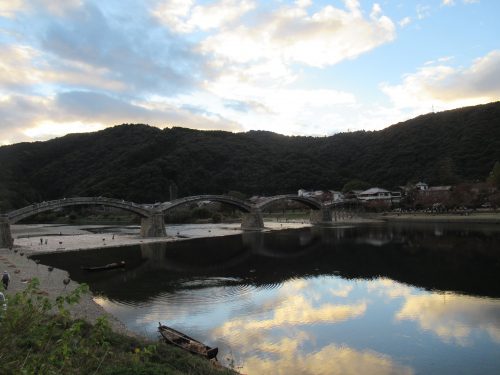
I walked along the southern bank of the Nishiki River in the direction of Kintaikyo, found an empty space along the railing, and stood there, watching the locals at the bottom ignite the kagaribi one by one. For baskets standing in the water, either one man had to wade into the river to light the kagaribi or they had to push a wooden dinghy filled with firewood next to the kagaribi to get the flame started and keep it going. Mundane as it was, I was rather amused by the sight of two men drifting across the river and playing basketball with the firewood, so to speak.
Once all the kagaribi were alive and burning with vigor, I crossed Kintaikyo once again to the north bank, where all the exciting stuff was happening. A kagura troupe was still getting ready for their performance, so I walked past them to see what other artistic things were set up. On the grassy field farther inland, they were holding an ikebana contest, for which there were three entries. The one below (and in my humble opinion, the most captivating one) was called “Shogetsu,” which consisted of two potted plants each filled with colorful flowers and seemingly linked by elongated blades of grass.
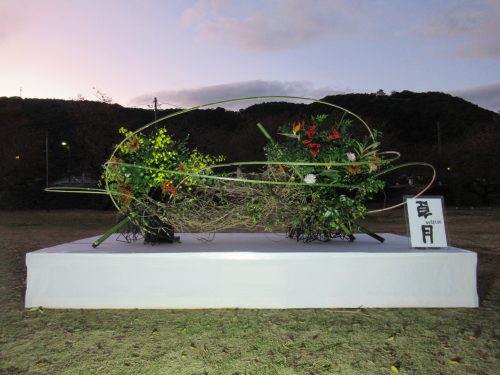
Alas, things wouldn’t truly kick off until the sky went dark, but as soon as I heard the sound of musical instruments, I rushed back to the makeshift kagura stage to find the show already underway. The venue was simple: the performers and musicians sat on straw mats on the ground, and spectators and cameras gathered around in an orderly manner to watch. I squeezed into the front to get a couple good shots like the video below, then promptly backed out so I wouldn’t obstruct anybody else’s view for too long.
There was a lot more to admire once the moon replaced the sun, and the previously shimmering illuminations now shone at their full potential. Close to the riverside were pyramids of white lanterns with calligraphy and stamps on them, surrounded by white lanterns that seem to have been designed by local children. The full moon in the night sky only amplified the overall beauty of this setup.
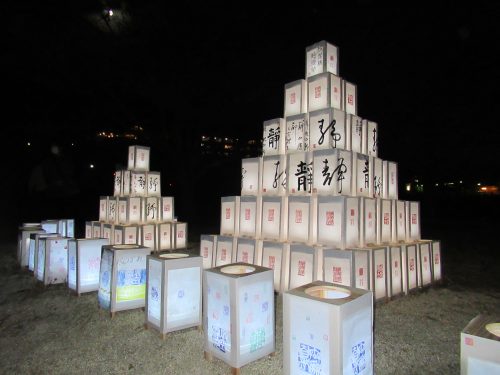
Elsewhere, from the kagura area continuing eastward along the path in the park were fake bamboo-shaped candles lighting the way. At one point, these bamboo candles form the shape of a heart and spell out the date, November 5th. The only thing that would make this setup even prettier would be real wax candles with burning flames.
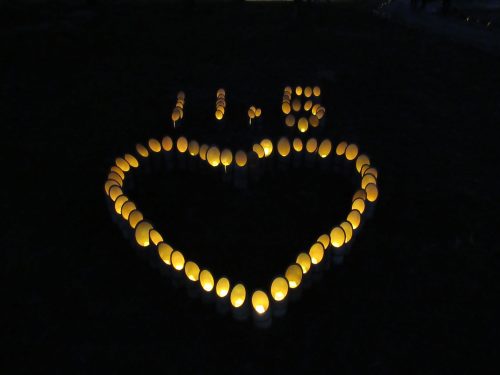
Just east of the above display was a tent serving up matcha-flavored amazake (rice wine with an alcohol content so low it’s advertised as non-alcoholic and even served to minors). The tent was manned by employees of the Iwakuni Kokusai Kanko Hotel, who briskly boiled batches of green tea-amazake in cooking pots before pouring some into little paper cups and serving them to customers. It was rather chilly out at this hour and one cup was only ¥100, so I warmed myself up with a cup before continuing on my merry way.
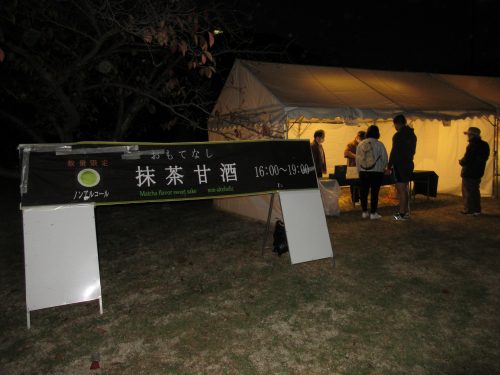
Back at the riverbank under Kintaikyo, I was able to get up close to the kagaribi, whose embers were mesmerizing to say the least.
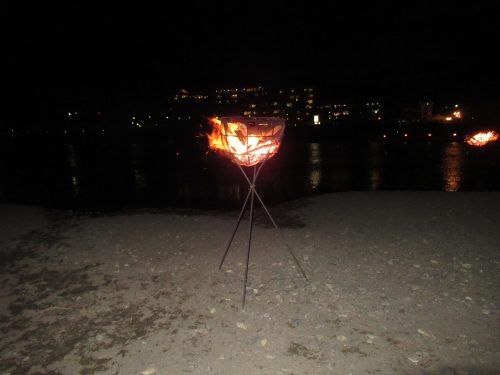
Tourists who passed underneath Kintaikyo to the other side found yet another object of interest: this array of blue tarp rectangles that I saw them assembling just this morning.
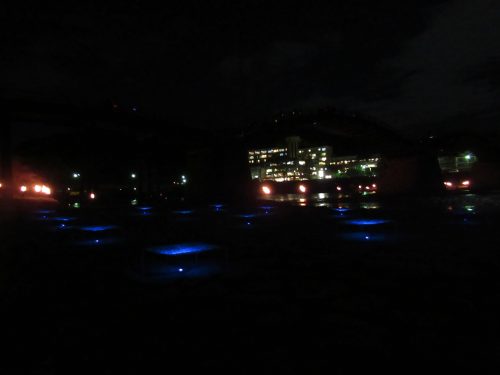
Each of these tarps was woven from used tea bags, which became obvious after taking a picture of one with flash. A woman from Iwakuni made all of these herself and asked people to donate their tea bags by mail during the days leading up to tonight’s event. I actually saw the ad online but forgot all about it, but I also didn’t drink any tea from tea bags during that period, so oh well.
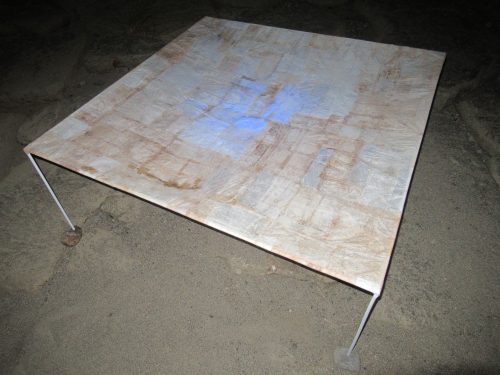
The final attraction of the night was being able to walk across Kintaikyo while carrying a glowing electric lantern in one’s hand. It was free and anybody could borrow a lantern from either side of the bridge before crossing, but the lanterns were in short supply which meant people had to wait a while for others to finish crossing and return their lanterns. I didn’t have to wait long, though, and soon enough, I too was on the bridge with a lantern in hand, gazing down at the kagaribi on one side and the blue teabag tarps on the other. Taking a picture of the constantly rotating lantern in one hand with my camera in the other proved quite impossible, but after setting the lantern on the bridge handrail, I was able to take one last photo to commemorate my visit to Iwakuni that day.
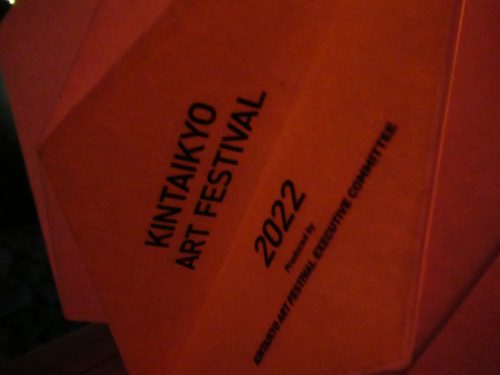
Iwakuni in autumn is certainly a sight to see during the day, but it only gets better on the nights of the Kintaikyo Art Festival. The nighttime display ends at 8:00 pm so transportation back to Hiroshima Station wasn’t an issue at all, but those who aren’t able to stay until nighttime can still enjoy the attractions in the daytime (they’d still be standing by the second day of the festival) and participate in the stamp rally, which lasts for a good while after the main festivities. Just about every part of Kintaikyo and its nearby attractions is great fun for the entire family, so those who want a tourist attraction that’s an exciting mix of popular and off-the-beaten-path need to swing by Iwakuni in early November to see its nocturnal beauty. After all, the lights only come on once the sun turns off.
Written by the Joy in Hiroshima Team
